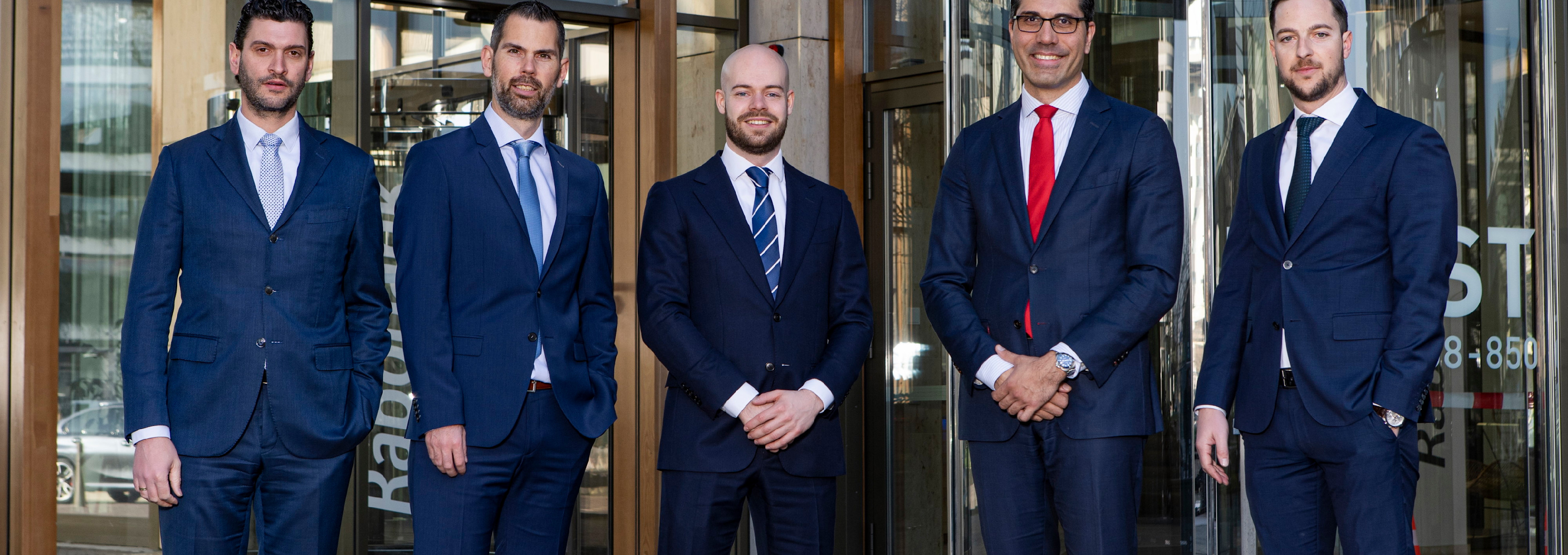

Index solutions that run the gamut of sustainability
Passive and sustainable investing are two key trends that have emerged in the asset management industry. As such, client interest in sustainable alternatives to passive market-cap weighted indices is increasingly growing. Our interview with the Sustainable Index Solutions team reaffirms this as we hear from Joop Huij, Simon Lansdorp, Georgi Kyosev, Jean-Paul van Brakel and Frank Wirds.
Summary
- Extensive portfolio management experience benefits index design
- Our factor and sustainable investing IP helps to address client needs
- Clients make use of Robeco indices in several different ways
Joop, the Sustainable Index Solutions team has a strong research background and substantial portfolio management experience. What are the benefits of this?
Joop Huij: “This experience has greatly benefited our client index design as we have gone through all aspects of investing. In other words, we have not just been running paper portfolios or simply relied on long-term backtests like some typical large benchmark providers. We have actually managed these portfolios day-to-day, performed the rebalancing, all in direct contact with, for example, risk management and our trading desk.”
“Being on top of the portfolios made us always look critically into specific design choices for our index strategies. As an example, this relates to our work in gaining more efficient exposure to factor premiums, for instance by avoiding unrewarded risks and smartly combining factors. But this also relates to efficient implementation, for example by explicitly taking turnover, liquidity and capacity considerations into account in the index construction process.”
“Most index providers, however, have a background in constructing benchmarks used for reporting purposes, but not for running an investment strategy on them. They are familiar with building indices with relatively simple construction rules, as opposed to having a background in asset management and performing the actual implementation, like we do.”
“Implementing liquid, broad market-cap weighted index approaches using these simple rules has had little negative impact. But for more active investment approaches, like multi-factor indices or sustainable indices, we believe that implementation efficiency should be at the core of the index design. We see, for example, that many of these generic indices have been highly inefficient due to poor index design, resulting in high turnover and highly illiquid trades.”
Simon, can you explain to what extent Robeco indices can provide clients with solutions to the challenges they face?
Simon Lansdorp: “Our clients can select a customized or a Robeco index solution and typically implement the strategy themselves or outsource the implementation to a third-party asset manager. Moreover, while we do not share our index methodology publicly, our clients do receive the benefit of having full transparency. Therefore, our low-cost and transparent indices can be seen as a direct answer to the passive investing trend, without the significant implicit costs associated with overcrowding or those related to index front-running.”1
“We allocate a significant amount of resources in conducting research to find new or better ways of implementing investment strategies. We enjoy doing this research and it also resonates well with our clients who expect us to stay ahead of the curve and to bring the latest insights into practice. With our pioneering mindset and adaptive index solutions, we always strive to implement the highest quality standards. The factor research we have put forward and our sustainable investing IP are concrete examples of that.”
“And finally, our indices are well-equipped to meet our clients’ sustainability objectives. Incorporating sustainability aspects in generic benchmark strategies is very difficult because of the active decisions that need to be taken. For example, excluding a country from a market-cap weighted index is very different to making explicit choices on what is a sustainable company and what is not. Robeco’s active mindset and our sustainable investing expertise help in that regard.”
Georgi, how is sustainability integrated in Robeco indices?
Georgi Kyosev: “We have made significant progress in the past three years on our sustainable investing philosophy. This includes, for instance, an explicit objective in terms of alignment with the UN Sustainable Development Goals (SDGs). For that purpose, we integrate the Robeco SDG Framework which is used to assess whether companies’ core activities significantly impact the SDGs positively or negatively.”
“Our research shows that ESG ratings are quite misaligned with asset owners’ preferences as they generally look at companies’ financial performance in relation to ESG issues.2 Our SDG scores, on the other hand, look at companies’ contributions to a better world and have been shown to be significantly better aligned with investors’ preferences. For our indices, we avoid taking positions in companies with negative, or very negative SDG scores, depending on the level of sustainability integration.”
“The second sustainability dimension for our indices refers to a low-carbon objective. By this, we aim to better align our clients’ portfolios with a world that moves towards a low-carbon economy. Not surprisingly, this is achieved by avoiding high emitters. Contrary to generic low-carbon strategies, however, we do not just look at carbon footprint. For instance, our research shows that a significant portion of green innovation is driven by the more pollutive segment of the market. In other words, naively divesting from high-emitting stocks could actually hamper the ambition of transitioning towards net zero."
“For that reason, we also explicitly look at companies’ climate SDG scores and retain those that can be seen as climate leaders in our indices, as these firms are deemed essential for facilitating the energy transition. Furthermore, our low-carbon approach integrates the fundamental research conducted by our Climate Strategist team, to not only lower the current carbon footprint profile of our indices, but also to further differentiate between climate laggards and leaders in an attempt to also contribute to a future low-carbon economy.”
Jean-Paul, can you expand on the work the team is doing on addressing transition risk?
Jean-Paul van Brakel: “We are currently in the process of implementing climate beta, a newly developed climate risk indicator that we are very excited about. Climate beta measures a stock’s or portfolio’s sensitivity to the climate risk factor. High climate beta stocks tend to be more vulnerable to climate transition risk compared to their low climate beta peers. Climate beta is derived from market prices, has forward-looking properties and captures a different dimension of climate risk compared to other existing climate metrics."
“For instance, climate beta can be used to reduce a portfolio’s sensitivity to climate transition risk. A reduction of climate transition risk is the third sustainability dimension we integrate in our indices. Climate beta can also help differentiate between climate leaders and laggards. As such, it can be used as an idea generator or screening tool by our fundamental equities teams, for example. Furthermore, since climate beta picks up different aspects of climate risk, our Climate Strategist team is exploring how it can be added to its existing climate analytics toolkit.”
Frank, which of the indices are most in demand and how do clients use the indices?
Frank Wirds: “We see a lot of traction for our sustainable indices across many client types. Both for low tracking error, low-carbon index solutions as well as our SDG Low Carbon indices, which clients see as a sustainable alternative to passive market-cap weighted indices for their equity portfolios. But we also see that many of our existing clients in multi-factor indices are taking the sustainable route. For instance, they have increased or are looking into increasing their sustainability ambitions by, for example, incorporating our SDG framework, lowering the carbon footprint and/or integrating climate beta to the process.”
“Our clients make use of our indices in many different ways. For instance, there are asset managers assigned by our clients to track our indices in segregated mandates or index funds. Other clients view our solutions as state-of-the-art model portfolios and they manage self-branded equity funds based on them. They can also opt to launch ETFs or index funds which closely track our indices. And some clients use our solutions to gain efficient factor exposure via a swap.”
“Indeed, we have seen increased demand from investment banks to build equity index linked notes in which our SDG-focused indices are used as the underlying index. So we see a very diverse use of our indices by a varying group of clients, including pension funds, sovereign wealth funds, insurers, consultants, as well as wholesale and investment banks.”
“Our clients also appreciate our flexibility in terms of designing custom index solutions. This comes in many forms, such as the level of activeness of the index, specific factor allocations, or the level and dimensions of sustainability integration. We work together with clients to combine the building blocks – SDG, low-carbon, climate risk and/or factors – they prefer to have in their index solution and to determine the risk budget. Even within the building blocks there is flexibility.”
Footnotes
1 See: Huij, J., and Kyosev, G., 2016, “Price response to factor index additions and deletions”, SSRN working paper.
2 See: Huij, J., Lansdorp, S., and Van Zanten, J., 2022, “Do ESG ratings align with the values of large investors?”, Robeco indices insights article; and Huij, J., Lansdorp, S., and Van Zanten, J., 2022, “Do ESG ratings align with popular thematic impact funds?”, Robeco indices insights article.
Important information
This information is for informational purposes only and should not be construed as an offer to sell or an invitation to buy any securities or products, nor as investment advice or recommendation. The contents of this document have not been reviewed by the Monetary Authority of Singapore (“MAS”). Robeco Singapore Private Limited holds a capital markets services license for fund management issued by the MAS and is subject to certain clientele restrictions under such license. An investment will involve a high degree of risk, and you should consider carefully whether an investment is suitable for you.



















